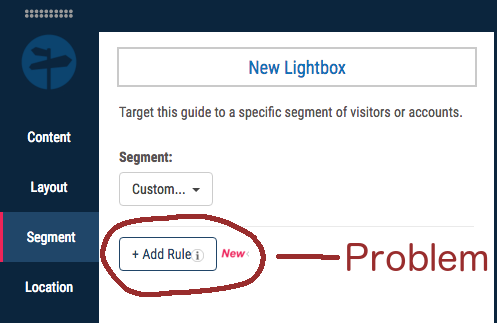Guides are awesome! At least that’s how we feel about them here at Pendo. And if one small piece of contextual help can help to improve the customer experience on a page, then why not 2, 4, 6, or 42? Who decides what is the right amount to publish, and how do you manage a process when users across multiple departments have publishing rights?
As our company has grown over the past few months, we’ve run into a number of issues around the deployment and management of the guides we deploy in Pendo. As a result, we have developed a lightweight management process that works pretty well. When I meet with our clients this topic comes up a lot, so I thought I would lay out our process here as well.
Why have a guides management process?
Our Guide SWAT Team was built out of necessity. We strongly believe that in-app messaging is the best way to communicate with—and educate—users. As a result, and as the company grew, we had different departments regularly adding guides into Pendo. The Marketing team (me) would post new feature and product announcements, the Support team would add documentation and how-tos, and the Product team would solicit user feedback. These are all great use cases, but what happens when Support wants to explain a feature at the same time Marketing is announcing an enhancement?

Suddenly, you’re no longer improving the customer experience, you’re making it cluttered and unclear. The problem is compounded when guides are set to show automatically.
The #igst is born
To address some of these challenges, and ensure that the guides we push in our product are always in-line with our branding and visual expression, we convened the Internal Guide
SWAT Team—or “igst”—to put some control around the process. The cross-functional team has one representative from Product, UX, Support, and Marketing. In a monthly meeting, our team:
- Runs an audit of all the public guides that are currently live in Pendo with special attention to those that launch automatically and/or are in a lightbox (Pro tip—using the different filtering criteria in the “Guides” page makes this much easier). Any conflicts are resolved, and old or outdated guides are retired.
- Identifies areas of the product which will need guide “support”—either features in the product that need additional explanation, or upcoming features that we will want to alert users about. Content owners and publishing dates for the new guides are assigned.
Managing guide publishing
Like most people, we hate unnecessary meetings, so in order to keep the “igst” meetings limited to no more than once a month, we needed a way to manage how and when guides are published. At the same time, we didn’t want to deter anyone from creating guides. So, we added a simple publishing process.
We added an “igst” channel in Slack. Anytime someone wants to publish a new guide, they stage it in Pendo, and then ping the channel to review. In order to be published the guide must be reviewed by marketing (for content) and UX (for design alignment), and comply with the following guidelines:
- Avoid automatic launching for guides—except for very important content / announcements. Automatic guides interrupt the user flow, and multiple guides quickly become intrusive.
- Use segments—Very few guides are relevant to the entire user base at the same time. Tailored messaging is more effective, and avoids messaging users with content that isn’t valuable to them
- Always add an expiration date. We’re constantly pushing small updates and new features. There’s no such thing as a guide that won’t become obsolete. Expiration dates ensure that we aren’t showing invalid content to users.
Results
So far the SWAT team process has been working well. The monthly audits are particularly valuable. Even with 1 or 2 guide authors, the number of published guides in an application can quickly build up so it’s useful to review and clean them up regularly. The publishing guidelines, while not perfect, have largely prevented any overlapping guide deployments, ensured that our messaging is consistent while still giving teams the freedom to reach out to customers. Guides are awesome, and our SWAT team keeps them that way. As we continue to grow, I’ll circle back to the blog and let you know how the process continues to work.
For more tips like these from our “igst” team, subscribe to the Pendo blog. Not a Pendo user yet? Learn more about our in-app guides and how they can help improve your customer success here.